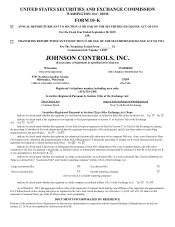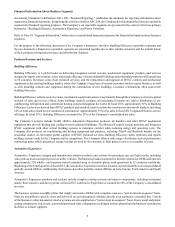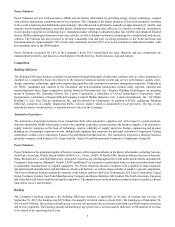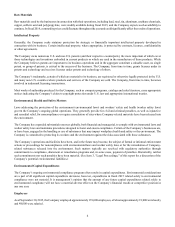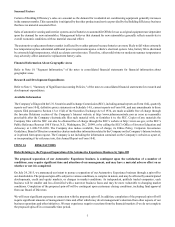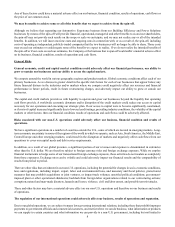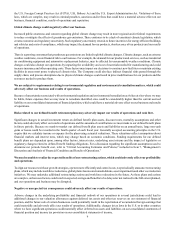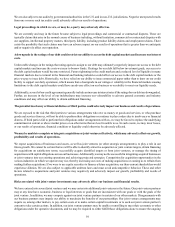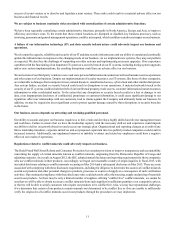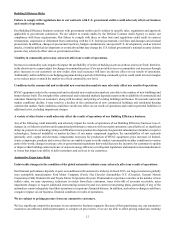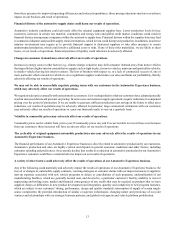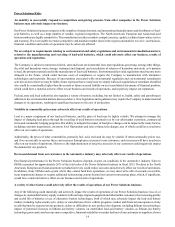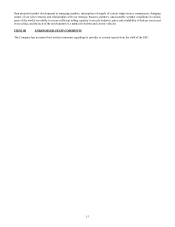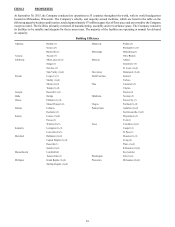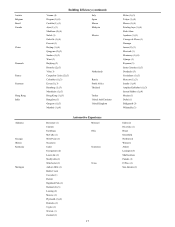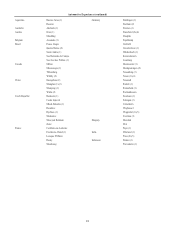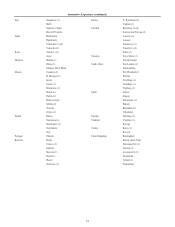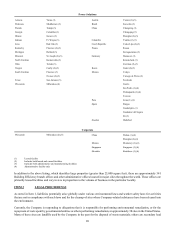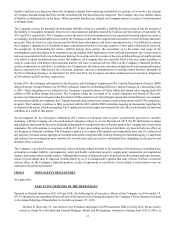Johnson Controls 2015 Annual Report Download - page 11
Download and view the complete annual report
Please find page 11 of the 2015 Johnson Controls annual report below. You can navigate through the pages in the report by either clicking on the pages listed below, or by using the keyword search tool below to find specific information within the annual report.11
success of a joint venture or to dissolve and liquidate a joint venture. These risks could result in a material adverse effect on our
business and financial results.
We are subject to business continuity risks associated with centralization of certain administrative functions.
We have been regionally centralizing certain administrative functions, primarily in North America, Europe and Asia, to improve
efficiency and reduce costs. To the extent that these central locations are disrupted or disabled, key business processes, such as
invoicing, payments and general management operations, could be interrupted, which could have an adverse impact on our business.
A failure of our information technology (IT) and data security infrastructure could adversely impact our business and
operations.
We rely upon the capacity, reliability and security of our IT and data security infrastructure and our ability to expand and continually
update this infrastructure in response to the changing needs of our business. As we implement new systems, they may not perform
as expected. We also face the challenge of supporting our older systems and implementing necessary upgrades. If we experience
a problem with the functioning of an important IT system or a security breach of our IT systems, including during system upgrades
and/or new system implementations, the resulting disruptions could have an adverse effect on our business.
We and certain of our third-party vendors receive and store personal information in connection with our human resources operations
and other aspects of our business. Despite our implementation of security measures, our IT systems, like those of other companies,
are vulnerable to damages from computer viruses, natural disasters, unauthorized access, cyber attack and other similar disruptions.
Any system failure, accident or security breach could result in disruptions to our operations. A material network breach in the
security of our IT systems could include the theft of our intellectual property, trade secrets, customer information, human resources
information or other confidential matter. To the extent that any disruptions or security breach results in a loss or damage to our
data, or an inappropriate disclosure of confidential, proprietary or customer information, it could cause significant damage to our
reputation, affect our relationships with our customers, lead to claims against the Company and ultimately harm our business. In
addition, we may be required to incur significant costs to protect against damage caused by these disruptions or security breaches
in the future.
Our business success depends on attracting and retaining qualified personnel.
Our ability to sustain and grow our business requires us to hire, retain and develop a highly skilled and diverse management team
and workforce. Failure to ensure that we have the leadership capacity with the necessary skill set and experience could impede
our ability to deliver our growth objectives and execute our strategic plan. Organizational and reporting changes as a result of any
future leadership transition, corporate initiatives and our proposed separation into two publicly-traded companies could result in
increased turnover. Additionally, any unplanned turnover or inability to attract and retain key employees could have a negative
effect on our results of operations.
Regulations related to conflict minerals could adversely impact our business.
The Dodd-Frank Wall Street Reform and Consumer Protection Act contains provisions to improve transparency and accountability
concerning the supply of certain minerals, known as conflict minerals, originating from the Democratic Republic of Congo and
adjoining countries. As a result, in August 2012, the SEC adopted annual disclosure and reporting requirements for those companies
who use conflict minerals in their products. Accordingly, we began our reasonable country of origin inquiries in fiscal 2013, with
our initial disclosure relating to conflict minerals occurring in May 2014 and a subsequent disclosure in May 2015. There are costs
associated with complying with these disclosure requirements, including for diligence to determine the sources of conflict minerals
used in our products and other potential changes to products, processes or sources of supply as a consequence of such verification
activities. Our continued compliance with these disclosure rules could adversely affect the sourcing, supply and pricing of materials
used in our products. As there may be only a limited number of suppliers offering "conflict free" conflict minerals, we cannot be
sure that we will be able to obtain necessary conflict minerals from such suppliers in sufficient quantities or at competitive prices,
or that we will be able to satisfy customers who require our products to be conflict free. Also, we may face reputational challenges
if we determine that certain of our products contain minerals not determined to be conflict free or if we are unable to sufficiently
verify the origins for all conflict minerals used in our products through the procedures we may implement.

